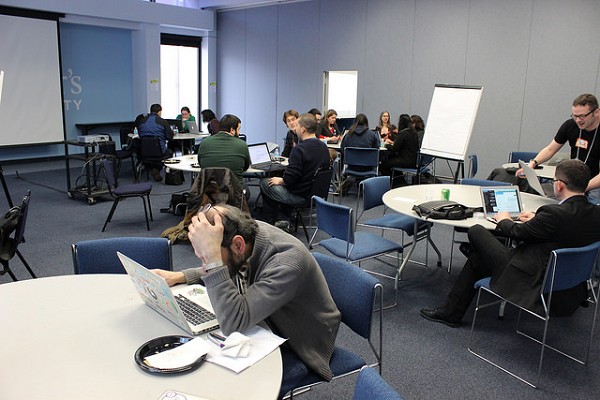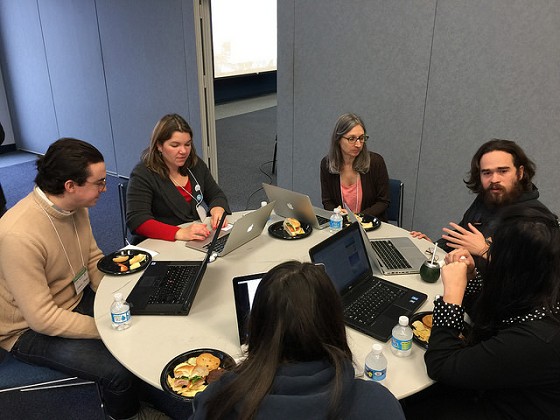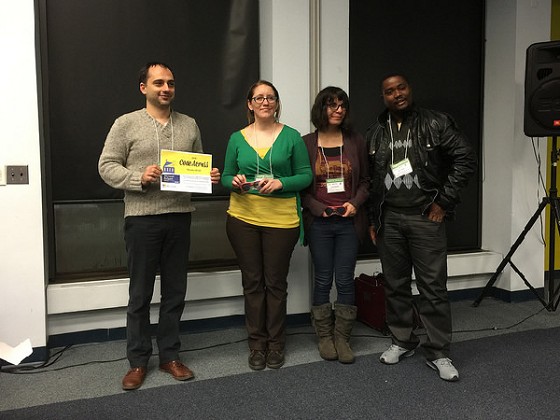Opinion: Kudos to PATH Data Jam Winners and Participants

When coders and others take on a particularly thorny problem and try to come up with creative solutions, NJTechWeekly.com likes to acknowledge it. This was the case with the PATH Data Jam, held on Feb. 21 at Saint Peter’s University, in Jersey City.
In December 2014, officials of the Port Authority of New York and New Jersey had floated a trial balloon about cutting overnight PATH service, which they’ve since rescinded. However, the idea evoked a strong reaction from residents of Hoboken, Harrison, Newark, Jersey City and other towns. They knew anecdotally that this was a bad idea, but they didn’t have the data to back their argument up.
The civic tech groups in Jersey City (CodeForJC) led by Anna Lukasiak, Emmanuel A. Simon and Akisia Grigsby and Newark (CodeForNewark) led by Isaiah “Zay” Little, organized a one-day hackathon as part of the Code for America CodeAcross national event. The goal was to try to get to the bottom of the PATH problem, using real data to investigate and understand when access to the PATH system was needed most.
St. Peter’s University got behind the effort, with the participating faculty members including: Dr. Elnardo J. Webster, project director, 21st CCLC Program Institute of Excellence; Dr. David S. Surrey, professor and chair of the Department of Sociology and Urban Studies; Dr. Alex Trillo, associate professor and director of the Latin American and Latino Studies Program; Dr. Donal Malone, associate professor of sociology and urban studies; and Philip M. Plotch, director of the Master of Public Administration Program and assistant professor of political science.
We reposted the NJ.com article describing that day here.

Months before the event, these groups began discussing the possibility of hosting a hackathon around PATH turnstile data with Dr. Anthony Townsend, adjunct assistant professor of urban planning at NYU and research director at the Institute for the Future.
Inspired by Dr. Townsend’s ideas, CodeForJC and CodeForNewark began working with the Port Authority to release PATH turnstile and NY Waterway data during the 10-month period in 2014 when weekend PATH service between the Exchange Place and World Trade Center stations was suspended to enable an upgrade of the signal system. The Regional Plan Association offered additional data on trans-Hudson transportation.
The Data Jam participants heard from such speakers as Robert Galvin, CTO of the Port Authority; Courtenay D. Mercer, New Jersey director of the Regional Plan Association; Joel Natividad, CEO and cofounder of Ontodia, a startup dedicated to open data; and Emmanuel A. Simon, a founding partner of OpenJC.
Now the winners have been announced, and more details as well as photos of the event can be found on the PATH Data Jam page.
The three judges were Dr. Elnardo Webster; Dr. Philip Plotch; and Otis Rolley, president and CEO of the Newark Community Economic Development Corp.
Winning the Breaking News Award for “investigative journalism through data” was Team Yulia, whose members were Antonio Borges, Tom Bruning, Roberto Martin, Milen Pavlov and Yulia Pavlov. They looked at the exits of riders from the Exchange Place station and at NY Waterway ferry usage during those weekends last year. They also looked at the impact of bad weather on rider usage.
The Data Mashup Award for “’best use of multiple datasets” was given to Team Ukko, which included Gary Campbell, Jaime Chaves, Andres Contreras, Daniel Fernandez and Fernando Hernandez, who also analyzed the connection between PATH data and bad weather. They asked how weather impacts PATH utilization, and analyzed turnstile data at 15-minute intervals, aggregating this data to match weather data.
Team Trio, made up of Joanna Riascos, Leonardo Velázquez and Shagufta Zareen, created a visual simulation of PATH usage based on station turnstile entrances and exits. They also drew their stats from a prior open data project. This team won the Where’s Waldo Award for the “best map visualization.”
Team Capacity, which included Christopher Castellano, Sydney Chan, Brian Evans, Kenneth Ford and Miraj Patel, modeled ridership capacity in relation to sporting events. This project won The Real World Award for an application that “solves a real problem” and the Haiku Award for “best 7-5-7 syllable project elevator pitch.” (The teams had been asked to create a haiku for their project. This team’s haiku: “Full capacity, Open Data makes Magic, The path to the PATH.”)

The winner of the Inception Award for the “most innovative mind-blowing project,” and the Humanitarian Award for “most impactful on the local community,” was Team Path Not Taken. The team members included Carla Astudillo, Jean Joseph, Victoria Nece, Nikhil Puri and Michalis Xyntarakis. Their project looked at what happens when PATH service is interrupted. They asked what the closest alternative modes of transportation are when PATH service is suspended and created a heat map showing a.m. and p.m. average and maximum boarding times.
Quentin Stenger, the lone member of Team Quentin, did some important work that benefitted everyone at the event. His project was to clean the turnstile code to make it available to the other teams. His results are here. He won the Dev Ninja Award for “technical excellence” in a project and the Foundation Award for the “greatest contribution others can use.”
Charlie Bini and Yi Wang were Team Awesome, using a Tableau software application to mash up PATH and turnstile data to create capacity and impact visualizations for the Port Authority. Through their project, they found out that a lot of people weren’t counted when leaving the system because they left through the handicap exits. This team won the Matrix Award for “best visual representation of the data,” the Yo Mama Award for settling “the ‘Best City’ argument once and for all,” and the Peek-a-Boo Award for “best insight from the data.”
What will be the real-world impact of these one-day projects? Some of the teams are continuing to develop their projects to further clarify PATH-usage issues, including possible scenarios that riders may face as the cities served by the PATH system continue to expand over the next three years. One team is already preparing a presentation to the Port Authority on their findings on capacity planning for the existing fleet of PATH trains

